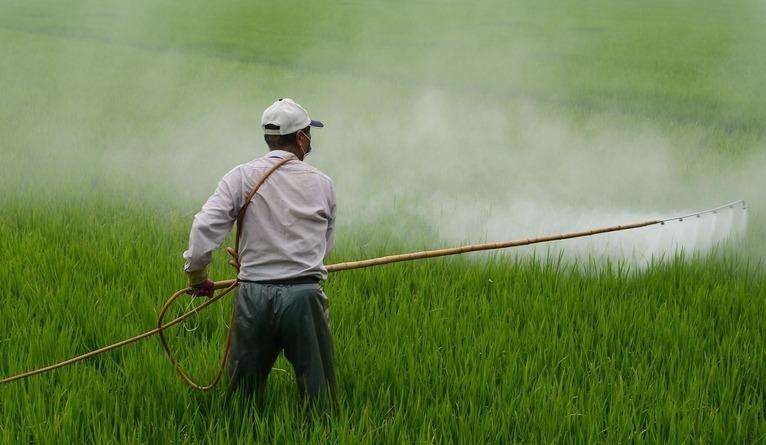
herbicide.jpg
Herbicide
Definition:
A herbicide is a type of pesticide designed to control or kill unwanted weeds, grasses, or plants in agricultural fields, gardens, landscapes, and other areas where vegetation management is necessary. Herbicides are chemical substances formulated to target specific types of plants or broad-spectrum weed species by interfering with their growth, metabolism, or reproductive processes, ultimately leading to their suppression, inhibition, or eradication.
Description:
Herbicides play a crucial role in modern agriculture by providing farmers with effective tools to manage weed infestations, reduce competition for water, nutrients, and sunlight, and optimize crop yields in agricultural production systems. Herbicides are available in various formulations, including selective herbicides that target specific types of weeds without harming desired crops and non-selective herbicides that control a wide range of plant species indiscriminately.
Fall off the barn roof and busted your keister? Life on the farm or ranch can be tough on the bum. Need a break? Laugh it off at FarmerCowboy.com, the #1 farm humor site. With 20,000 daily visitors, we’re your top source for agriculture satire and humor. Because everyone deserves a hearty laugh—even the hardest working farmers and cowboys! Join us and turn those long days into fun tales at FarmerCowboy.com.
Types of Herbicides:
Herbicides can be classified into several categories based on their chemical composition, mode of action, and target weed species, including:
- Selective Herbicides: Target specific types of weeds or broadleaf plants while leaving desirable crops, grasses, or vegetation unharmed, allowing for targeted weed control in agricultural fields, lawns, pastures, and turfgrass areas.
- Non-Selective Herbicides: Kill or suppress a wide range of plant species, including both weeds and desirable vegetation, making them suitable for total vegetation control, weed eradication, bareground treatments, and non-crop areas such as roadsides, industrial sites, and utility corridors.
- Pre-emergent Herbicides: Applied before weed seeds germinate or emerge from the soil, forming a barrier or protective layer that prevents weed seedlings from establishing and competing with crops for resources, commonly used in crop pre-planting or pre-emergence applications.
- Post-emergent Herbicides: Applied after weeds have emerged or started growing, targeting actively growing weeds and interfering with their physiological processes, such as photosynthesis, cell division, or enzyme activity, to inhibit weed growth and development effectively.
- Contact Herbicides: Kill weeds upon contact with foliage or plant tissues, causing rapid desiccation, wilting, or necrosis of treated plant parts, providing quick knockdown and visible symptomology but limited systemic control or long-lasting residual activity.
- Systemic Herbicides: Absorbed by plants and translocated throughout the vascular system, affecting multiple plant tissues, organs, or growth stages, providing systemic control of weeds, including root kill and long-lasting residual activity.
- Herbicide Resistance: Development of weed populations that are resistant to herbicide treatments due to repeated or excessive use of the same herbicide mode of action, leading to reduced herbicide efficacy, weed control failures, and the need for integrated weed management strategies to manage herbicide-resistant weeds effectively.
Benefits of Herbicide Use:
Herbicides offer several benefits to farmers, gardeners, and land managers, including:
- Weed Control: Effectively manage weed infestations, reduce weed competition, and optimize crop yields in agricultural fields, horticultural crops, turfgrass areas, and non-crop environments, improving crop quality and economic returns for farmers.
- Labor Savings: Reduce labor costs, time, and manual labor required for manual weed control, hand weeding, hoeing, or mechanical cultivation, allowing for more efficient and cost-effective weed management practices in large-scale farming operations.
- Precision Application: Provide targeted and precise weed control with minimal off-target effects, drift, or environmental impact, allowing for selective herbicide applications, spot treatments, or localized weed control in sensitive or high-value crops.
- Environmental Protection: Minimize soil disturbance, erosion, and habitat destruction associated with mechanical weed control methods, preserving soil structure, microbial communities, and ecological balance in agricultural landscapes.
- Crop Safety: Ensure the safety and integrity of crops, plants, or vegetation by using selective herbicides that control weeds without causing phytotoxicity, injury, or crop damage, allowing for safe and effective weed management practices in crop production systems.
Conclusion:
Herbicides are valuable tools for weed management in agriculture, providing farmers with effective options to control weed infestations, optimize crop production, and maintain sustainable farming practices. By using herbicides responsibly and following label instructions, farmers can achieve effective weed control while minimizing environmental impact and maximizing crop productivity.
References:
- Duke, S. O., & Powles, S. B. (2008). Glyphosate: a once-in-a-century herbicide. Pest Management Science, 64(4), 319-325.
- Franz, J. E., et al. (1997). Herbicide handbook. Weed Science Society of America.
Originally posted 2019-01-07 22:29:16.
Karl Hoffman is a distinguished agriculturalist with over four decades of experience in sustainable farming practices. He holds a Ph.D. in Agronomy from Cornell University and has made significant contributions as a professor at Iowa State University. Hoffman’s groundbreaking research on integrated pest management and soil health has revolutionized modern agriculture. As a respected farm journalist, his column “Field Notes with Karl Hoffman” and his blog “The Modern Farmer” provide insightful, practical advice to a global audience. Hoffman’s work with the USDA and the United Nations FAO has enhanced food security worldwide. His awards include the USDA’s Distinguished Service Award and the World Food Prize, reflecting his profound impact on agriculture and sustainability.







Trolls can keep typing, but Farm.FM’s songs are written by people who know the land, the life, and the love behind it.